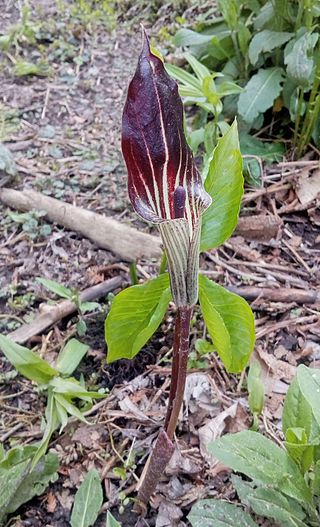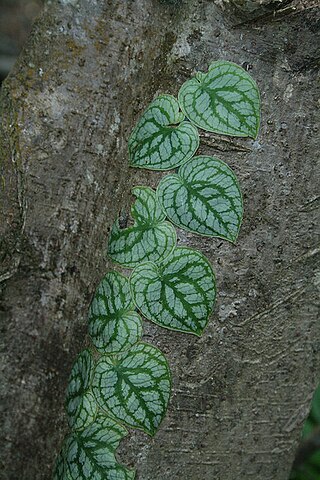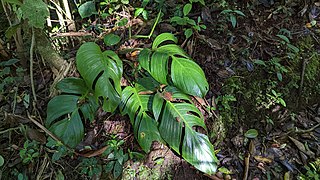
The Araceae are a family of monocotyledonous flowering plants in which flowers are borne on a type of inflorescence called a spadix. The spadix is usually accompanied by, and sometimes partially enclosed in, a spathe. Also known as the arum family, members are often colloquially known as aroids. This family of 114 genera and about 3,750 known species is most diverse in the New World tropics, although also distributed in the Old World tropics and northern temperate regions.

Monstera deliciosa, the Swiss cheese plant or split-leaf philodendron is a species of flowering plant native to tropical forests of southern Mexico, south to Panama. It has been introduced to many tropical areas, and has become a mildly invasive species in Hawaii, Seychelles, Ascension Island and the Society Islands. It is very widely grown in temperate zones as a houseplant.

Richard Spruce was an English botanist specializing in bryology. One of the great Victorian botanical explorers, Spruce spent 15 years exploring the Amazon from the Andes to its mouth, and was one of the very first Europeans to observe many of the places where he collected specimens. Spruce discovered and named a number of new plant species, and corresponded with some of the leading botanists of the nineteenth century.

Monstera is a genus of 59 species of flowering plants in the arum family, Araceae, native to tropical regions of central and south America.

Arisaema triphyllum, the Jack-in-the-pulpit, is a species of flowering plant in the arum family Araceae. It is a member of the Arisaema triphyllum complex, a group of four or five closely related taxa in eastern North America. The specific name triphyllum means "three-leaved", a characteristic feature of the species, which is also referred to as Indian turnip, bog onion, and brown dragon.

Epipremnum is a genus of flowering plants in the family Araceae, found in tropical forests from China, the Himalayas, and Southeast Asia to Australia the western Pacific. They are evergreen perennial vines climbing with the aid of aerial roots. They may be confused with other Monstereae such as Rhaphidophora, Scindapsus and Amydrium.

Monstera epipremnoides is a species of flowering plant in the family Araceae, endemic to Costa Rica. A clone in cultivation was formerly thought to be of this species, but after comparison with wild populations of M. epipremnoides, the plant in cultivation has since been registered as a cultivar of the name Monstera 'Esqueleto'.

Monstera acuminata, or shingle plant, is a species of flowering plant from family Araceae which is widespread from Mexico to Central America. It is abundant in central Petén and extends north to San Luis Potosí, making it the northernmost of the species of Monstera.

Monstera dubia is a species of plant in the genus Monstera native to Central and South America. M. dubia is known for the dramatic transformation its foliage makes as it climbs from seed stage on the forest floor, to shingling closely up a host tree trunk or other surface, until mature leaves with fenestrations similar to Monstera deliciosa appear. This transformation is an example of leaf dimorphism. Dubia refers to dubious, because authors were not certain that the species fell within the genus Marcgravia, where it was initially placed.

Monstera obliqua is a species of the genus Monstera native to Central and South America. It is hemiepiphytic like most other Monstera species. The plant is particularly known for its foliage, which is, in mature specimens of a few varieties, highly perforated, sometimes described as having more empty space than leaf. An illustration of the general variation in adult leaf shape from different individuals of this species can be found in Michael Madison's A Revision of Monstera. The species is not commonly cultivated, but the name is often misapplied to specimens of the more widespread Monstera adansonii.
Thomas Bernard Croat is an American botanist and plant collector, noteworthy as one of botanical history's "most prolific plant collectors". He has collected and described numerous species of plants, particularly in the family Araceae, in his career at the Missouri Botanical Garden.

Monstera pinnatipartita is a species of flowering plant in the genus Monstera native to Central America and the tropical areas of South America. Like the more common Monstera deliciosa the plant has green foliage that becomes highly fenestrated when mature, though both immature and mature leaves are less heart shaped. Its name refers to the deeply split mature leaves that are pinnate.
Monstera minima is a species of flowering plant in the genus Monstera of the arum family, Araceae. Its binomial name minima refers to its tiny foliage, and it is indeed the smallest of the Monstera species when it comes to leaf size. It is most easily distinguished from other species in the genus due to the fact that its peduncles are much longer than its leaves.

Monstera monteverdensis is a species of flowering plant in the arum family, Araceae. Its adult form is characterized by pinnatifid margins with up to eight lobes per side, with occasional fenestrations away from the midrib. Leaves can grow as large as 60 cm long and 30 cm wide. It is named after the city of Monteverde, where the species is abundant.

Anthurium ernestii is a species of plant in the genus Anthurium native to South America. Found from southern Colombia to Peru and western Brazil, it typically grows below 500 metres (1,600 ft).
Monstera subpinnata is a species of flowering plant native to Bolivia, Peru, Ecuador and Colombia. It grows as an epiphyte. The plant is best known for its pinnate leaves, which are unusual within the genus Monstera. The species can grow as tall as 12 m, with leaves growing as large as 40 cm long and 30 cm wide.

Monstera tuberculata, also called the giant Monstera or the giant velvet-leaf Monstera, is a species of plant in the genus Monstera native from Mexico south to Panama. It grows in lowland wet tropical biomes up to 200 metres (660 ft) in elevation. Similar to Monstera dubia and a few other species in its genus, when young M. tuberculata has a shingle-like growth habit with leaves tightly pressed against the trunks of trees. As it matures, it has short-stemmed, oval leaves that lack the fenestrations of better-known species like Monstera deliciosa. Unusually for an aroid, its fruit hangs like a pendant.

Philodendron opacum is a species of flowering plant. It has a native range extending from Southeast Nicaragua to Ecuador and includes Colombia, Costa Rica, Ecuador, Nicaragua, Panama. Its habitat is largely restricted to the Tropical Wet Forest and Premontane Wet Forest life zones in Central America, but in South America extends into Premontane Rain Forest (Colombia) and Tropical Moist Forest (Ecuador).

Monstera tenuis is a species of plant in the genus Monstera native to Central America, from Nicaragua to Panama. It grows in wet tropical habitats below 1,600 meters (5,200 ft). Like many others in its genus, like Monstera dubia, the plant starts life on the forest floor and then climbs tree trunks in a shingling fashion with leaves tightly appressed to the surface of the trunk. When it reaches a sufficient height, the leaf morphology dramatically changes to pinnate in nature. The name of the species, which means "thin" in Latin, refers to the juvenile leaves.

Monstera praetermissa is a species of plant in the genus Monstera native to Brazil. It grows in wet tropical forests from 50–900 metres (160–2,950 ft) in elevation. It is most similar to Monstera obliqua and Monstera xanthospatha, but differs from these in habitat (Brazil) and in its inflorescence. Like many in its genus, the species transitions from a juvenile leaf shape, typically at about 15 centimetres (5.9 in) in growth, to an adult leaf that has up to five perforations per side. Its species name means "overlooked" in Latin, due to its only recent scientific description in 2004 and lack of attention from collectors.


















